The article below was written in a letter Sharon Turner in 1827 and was first posted in the CAIS (Circle of Ancient Iranian Studies) venue hosted by Shapour Suren-Pahlav.
Kindly note that the images and accompanying descriptions inserted below do not appear in the original article posting in CAIS.
===========================================================
If more important communications be not, at the present moment, occupying the attention of the Royal Society of Literature, it may not perhaps be wholly uninteresting, if I submit to its consideration a few circumstances in regard to the Asiatic origin of our Anglo-Saxon ancestors, which have lately occurred to me on examining the affinities of their ancient language.
It has been stated in the History of the Anglo-Saxons, that the most probable derivation of this people which had been suggested, was that which deduced them from the Sakai or Sacae, who, from, the Caspian, besides branching into Bactriana on the east, had also spread westward into the most fertile part of Armenia, which, from them, as we learn from Strabo, was called Sakasina.
Pliny terms the Sakai, who settled there, the Sacassani; which is so similar in sound to Saca-sunu, or the sons of the Sakai, that we are tempted to identify the two appellations. It was Goropius Becanus who first hinted this etymology: the celebrated Melanchthon adopted it; and though, as is usual on such subjects, others doubted and disputed, our Camden gave it the sanction of his decided preference.
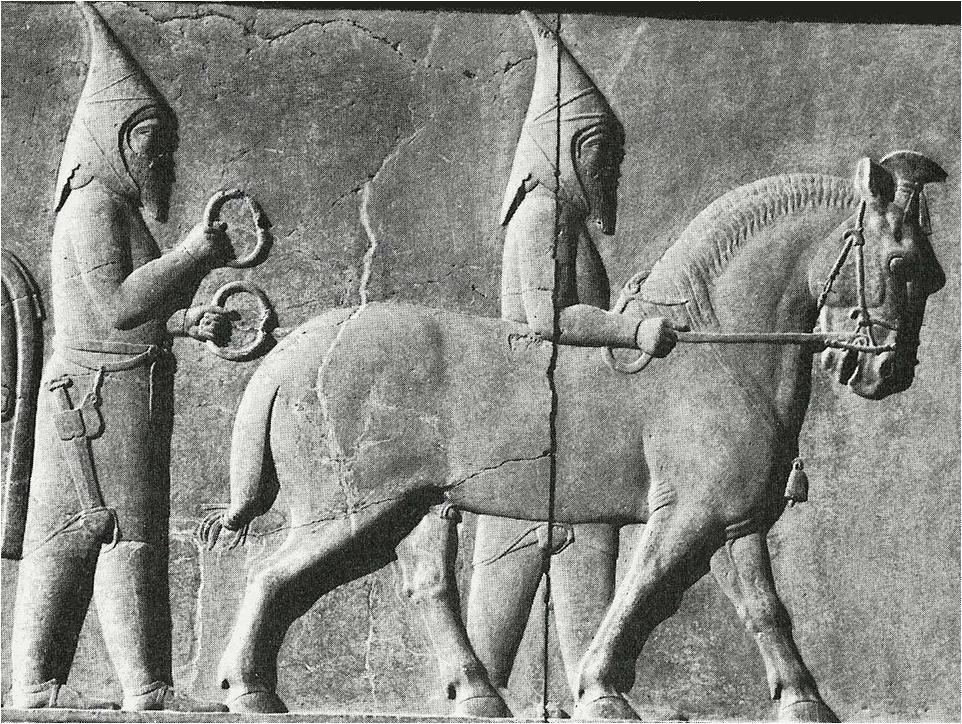
Eastern Scythians or “Saka Tigrakhauda” (Pointed cap Saka) as depicted in Persepolis. The Scythians played an important role in the military machine of the Achaemenids. A branch of the Scythians or Saka, the Parthians, were to revive the Iranian kingdom after Alexander’s conquests and his Seleucid successors.
It appeared to me to be the most rational derivation which had been mentioned; and the fact that Ptolemy, writing in the second century after Strabo and Pliny, actually notices a Scythian people, who had sprung from the Sakai, by the very name of Saxones, seemed to verify the conjecture, that the appellative Saxones did originate from Saca-sunu, or the sons of the Sakai.
The Romans spelt the word with a c instead of a k, and we therefore call them Sacae, with the s sound of the c.But this is only our mispronunciation of the Roman c; for we find that Cicero’s name is written in the Greek authors who mention him, as Kikeroo.
The preceding derivation thus leads to the opinion, that the progenitors of our Anglo-Saxon ancestors came from Asia into Europe; and that before they made this emigration, they had dwelt in Armenia and in the regions about the Caspian.
The Honourable Mr. Keppell, in his late interesting travels, visited this country, and thus notices it. After crossing the river Arras – the Araxes of Plutarch – he says:
“Between this river and the Kur – the ancient Cyrus or Cyrnus – is the beautiful province of Karabaugh, formerly the country of the Sacae or Sacassani, a warlike tribe of Scythians, mentioned by Pliny and Strabo, and supposed to be the same people as our ancient ancestors the Saxons.”
After quitting Karabaugh, Mr. Keppell proceeded to Shirwan, the Albania of the ancients. The beautiful province of Karabaugh, between the Arras and the Kur – the ancient Araxes and Cyrnus – may therefore be considered as one of the Asiatic localisations of our Anglo-Saxon ancestors. The Kur has been the late boundary of the Russian acquisitions in this district.
The late war between the Russians and the Persians has been chiefly carried on in or near the regions where the ancient Sakai or Sacassani were seated, and which appear to have begun from the south of the Kur. If the Russians make any further acquisitions in these parts, they will become possessed of the country of our Sakai ancestors.
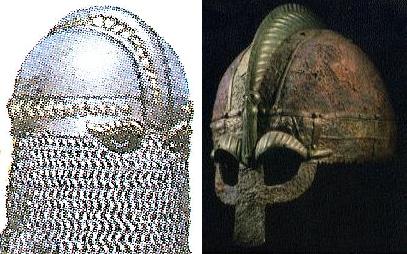
Viking Helmet (Right; Picture Source: English Monarchs) and reconstruction of earlier Sassanian helmet at Taghe Bostan, Kermanshah, Iran (Left; Picture Source: Close up of Angus Mcbride painting of Sassanian knight at Taghe Bostan, Wilcox, P. (1999). Rome’s Enemies: Parthians and Sasanid Persians. Osprey Publishing, p.47, Plate H1).
These circumstances, drawing the mind to this part of the world, led me to recollect that former antiquaries had observed a few words in the Persian language to resemble some in the Saxon. Camden mentions, that “the admirable scholar, Joseph Scaliger, has told us that fader, muder, brader, tuchter, band, and such like, are still used in the Persian language, in the same sense as we say father, mother, brother, daughter, and band.” (Camden’s Brit. Introd. cxxiii.)
Musing upon this intimation, it occurred to me, that if five words, so much alike as these, were found in the two languages, an attentive comparison of the Persian with the Anglo-Saxon might discover many more, if the allegation were really true, that the Saxons had come from these regions; and in that case, if any considerable number of similarities were really existing in the two languages, they would tend to confirm the belief, that the origin of our Saxon forefathers should be thus sought in Asia, and that their primeval ancestors had gradually moved from the Caspian Sea to the German Ocean.
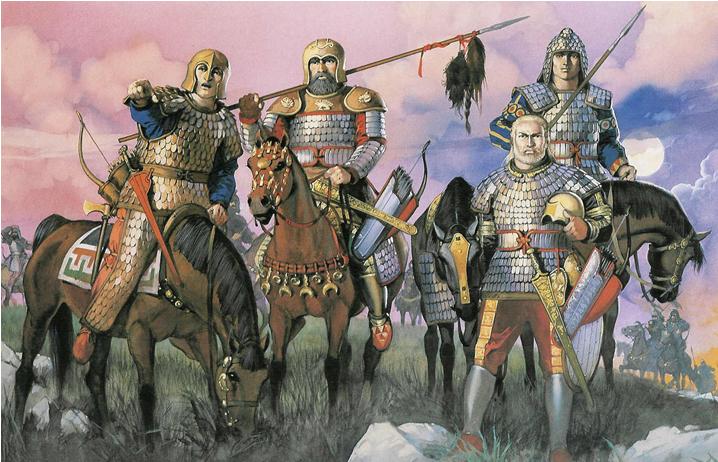
Scythians on the steppes of the ancient Ukraine. Scholars are virtually unanimous that the Scythians were an Iranian people related to the Medes and Persians of ancient Iran or Persia (Painting by Angus McBride).
This view of the subject induced me to attempt a cursory examination, whether such resemblances could, by a general inspection, be perceived, as would satisfy the mind that the chorographical relationship was not an unfounded conjecture.
But it was obvious, that whatever the ancient identity between these languages may have been in their original state, no very great proportion of it could be expected to be visible now, because the Saxons have been separated from these regions at least 2000 years; and in their progress along the north of Asia, and through the whole breadth of the upper surface of Europe, and amid all the evils, sufferings, triumphs, and events, which must have befallen them before they reached the mouth of the Elbe; and from the new scenes and conflicts which accompanied their three centuries of depredations on the Roman empire and upon the ocean, and which afterwards, for four hundred years more, awaited them in Britain, before those works were written which display their language to us; – from all these causes, the Anglo-Saxons, in the days of Alfred, must have used a very different tongue, in the mass of its words, from that simpler and ruder one which their progenitors had conversed with in the beautiful province of Karabaugh, and on the Araxes, the Kur, and the Caspian.
So, during the same lapse of time, the Persian language has ceased to be what it was in the days of Cyrus or Darius. It has become, within the last 1,000 years, the most polished language of the Eastern world, and has been most exercised in clothing with select and ornate phrase the finest effusions of the Oriental genius.
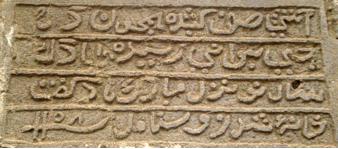
Persian (Zoroastrian) inscription in Ateshgah (Source: Farroukh Jorat).
Modern Persian can, therefore, be scarcely less unlike the original language of those, in his war, against whom the self-confident Julian found an early grave, instead of the victorious triumph he expected, than our present English is to the Anglo-Saxon of the same period. Neither Persian nor Saxon are now what they were when the Sakai and the Persae confronted each other on their dividing rivers, and from their bordering mountains. Hence no such pervading identity could be expected as may yet be traced between the Welsh, the Bas Breton, the Irish, and the Gaelic, however originally similar.
The likeness would be also less, because the Saxons did not spring from the Persians. No one has alleged this parentage. The Sakai were the relatives only, not the children of the Persae. So far from any filial or paternal feelings existing between them, the most furious hostilities disparted the two tribes; and at one epoch, the Persians, by attacking the Sakai by surprise, nearly exterminated them.
This disaster disinclined our valuable antiquary, Sheringham, from adopting this derivation of our ancestors. But as it is manifest that no attack of surprise could annihilate at that time more than the forces which were surprised, the calamity is more likely to have been a reason for the rest of the Sakai, after this weakening catastrophe, to have moved hastily out of their pleasing settlements in those parts of the world, and to have migrated westward to a safer locality.
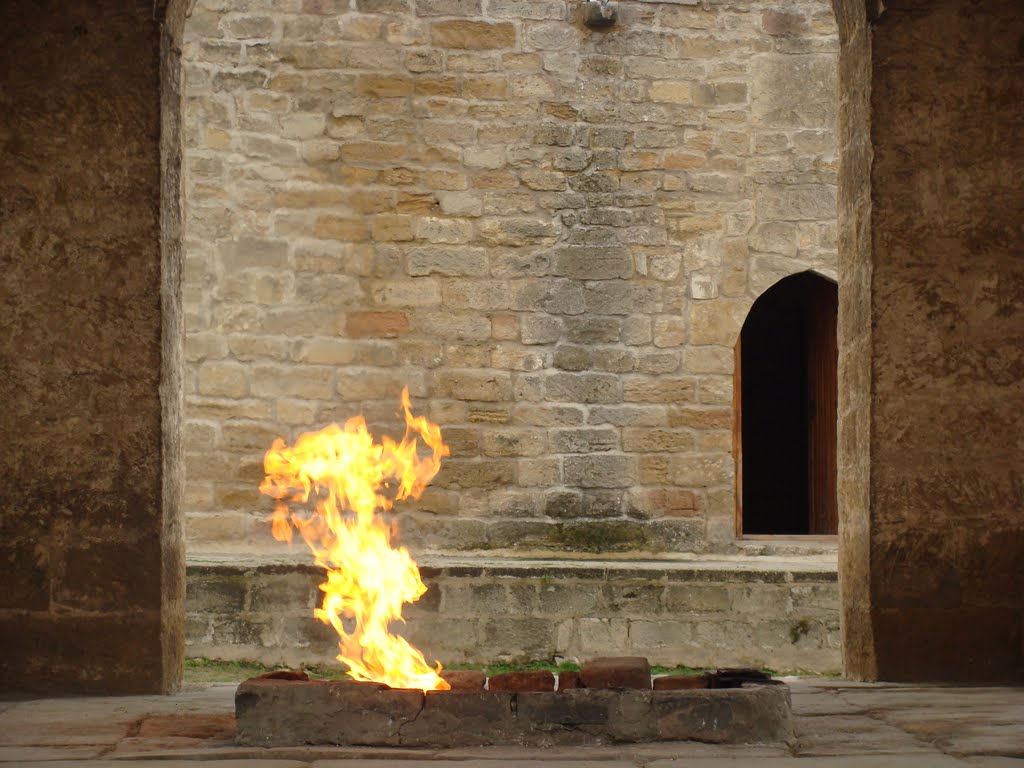
The main fire altar at the Atash-kade (Zoroastrian Fire-Temple) of Baku in the Republic of Azerbaijan (known as Arran and the Khanates until 1918) (Picture Source:Panoramio). This site is now registered with UNESCO as a world heritage site.
This defeat may have forced them from Armenia to other districts nearer Europe; and the war of the Romans, or of Mithridates, or similar disturbing causes, may have afterwards impelled them to proceed onward to the Vistula, and at last to seek refuge on the islands and peninsula of the western extremities of the continent.
The probability is, that all the tribes which anciently inhabited the immediately conterminous countries were, for the most part, branches of the same main parental stem. The Persae, the Sakai, and their neighbours, may be therefore considered as ramifications of the great Scythian stock – part of the audax genus of Japetus, or Japhet; and as such, although the old Persians and the Sakai would not have spoken the same language in all its words and forms, yet their respective tongues would be dialects of their family original, and therefore would have many terms in common, as we still find between the ancient Franco-theotisc and the Saxon.
Of these assimilating terms, I expected that many fragments would be preserved, both in the Anglo-Saxon and in modern Persian, notwithstanding all the changing fortunes of the two nations; but that they would, from these mutations, exist and be perceptible now only as fragments.
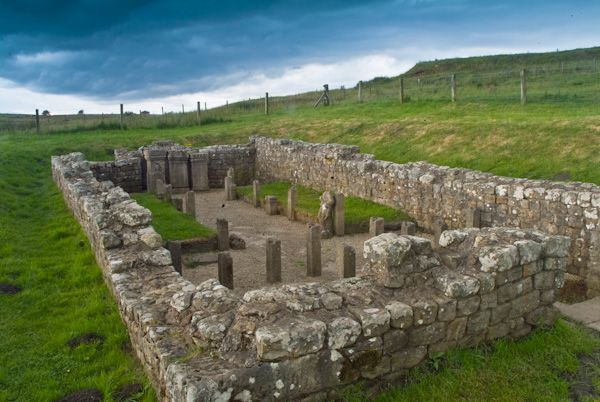
Remains of the Temple of Mithra at Carrawburgh, England (Source: Britain Express). The culture 0f Mithras continues to endure among the Iranians (within Iran and the Kurds of the Near East beyond modern-day Iran. The Kurds speak West Iranian languages (i.e. Kurmnaji, Gowrani, etc.) that are akin to Persian and Luri.
Proceeding on this principle – that if the ancestors of the two nations did once live in vicinity to each other, although this was 2000 years ago, some indications of their neighbourhood would appear from subsisting similarities in their languages, and expecting to find these only as occasional fragments, I have compared the Anglo-Saxon with the modern Persian. The result has been, that, upon a general examination, I have found 162 Persian words which have a direct affinity with as many Anglo-Saxon terms of the same meaning; and these I beg leave to submit to the notice of the Society.
But before I attach the list of these, I will take the liberty also of mentioning, that I thought it right, after these similarities had been ascertained, to consider that two other languages, older than the modern Persian, had prevailed in that country. These were the Pehlvi and the Zend. The latter, the most ancient that we know of in those parts from actual specimens; the other, the Pehlvi, an intermediate one, in point of chronology, between the Zend and the Persian.
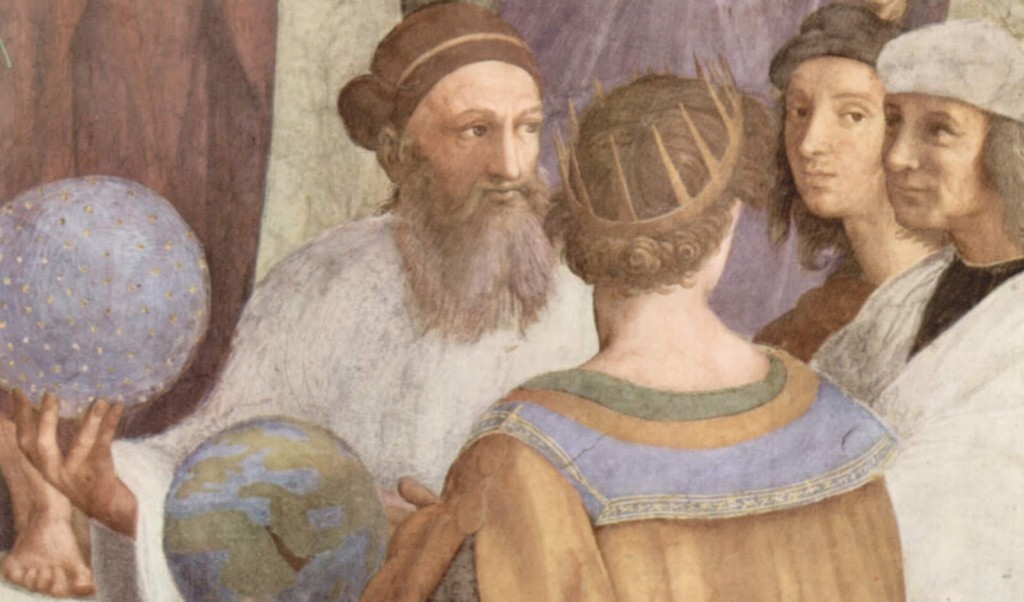
A detail of the painting “School of Athens” by Raphael 1509 CE (Source: Zoroastrian Astrology Blogspot). Raphael has provided his artistic impression of Zoroaster (with beard-holding a celestial sphere) conversing with Ptolemy (c. 90-168 CE) (with his back to viewer) and holding a sphere of the earth. Note that contrary to Samuel Huntington’s “Clash of Civilizations” paradigm, the “East” represented by Zoroaster, is in dialogue with the “West”, represented by Ptolemy. Prior to the rise of Eurocentricism in the 19th century (especially after the 1850s), ancient Persia was viewed positively by the Europeans. For more see Ken R. Vincent: Zoroaster-the First Universalist…
Of both the Zend and the Pehlvi, M. Anquetil found some specimens among the ancient manuscripts which he consulted in exploring and translating the Zendavesta, or sacred book of the still subsisting worshippers of the sacred fire in those regions. Recollecting this fact, I have been led also to look into these specimens, and I have observed fifty-seven words in these fragments of the Zend language, which resemble as many in the Anglo-Saxon, and forty-three of accordant similarities between our old tongue and the Pehlvi.
These one hundred and sixty-two Persian words, fifty-seven Zend, and forty-three Pehlvi, present to us two hundred and sixty-two words in the three languages that have prevailed in Persia, which have sufficient affinity with as many in the Anglo-Saxon to confirm the deduction of our earliest progenitors from these regions of ancient Asia.
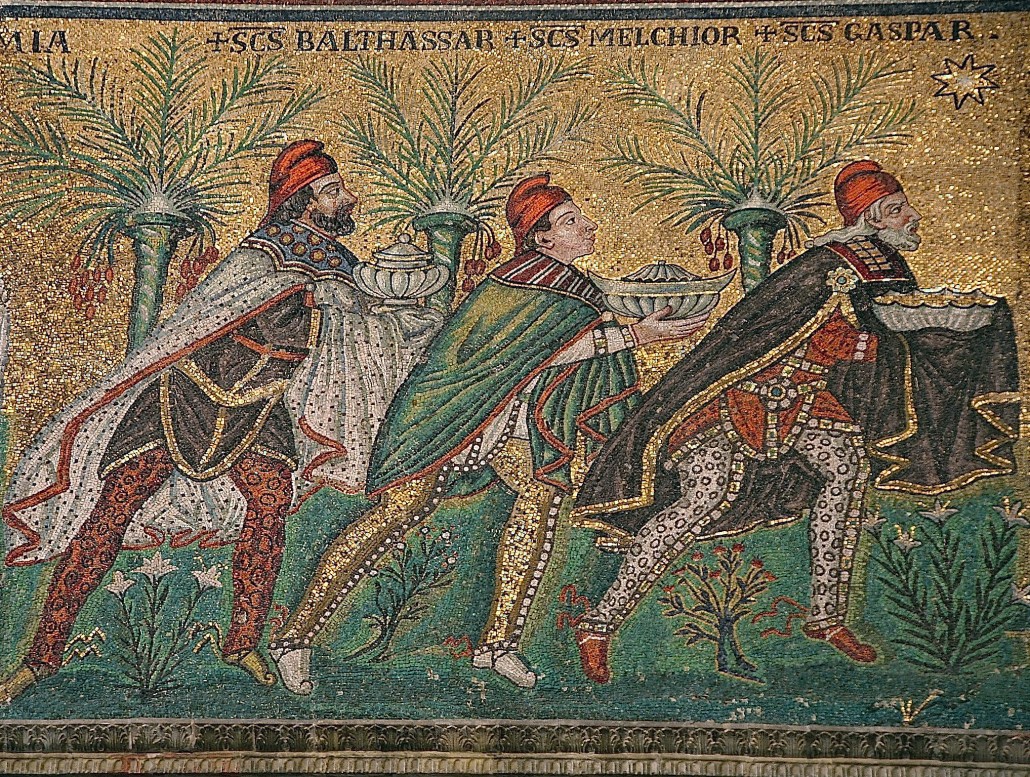
The Three Wise Men as depicted in Ravenna (Sant’Apollinare Nuovo), Italy (Source: Public Domain). Note the European depiction of Partho-Sassanian Iranian dress, caps and cloaks.
That these affinities are too many to be ascribed to mere chance, there seems to be no difficulty in affirming. But on adverting to the positions suggested in my former papers, of a primeval oneness of language among mankind, and of the abruption of that into the diversities which now pervade the world, it is a reasonable question, whether these two hundred and sixty-two similarities are only remains of the primitive unity, or whether they be indications of specific subsequent relationship of two of the newer languages that were formed after the dispersion.
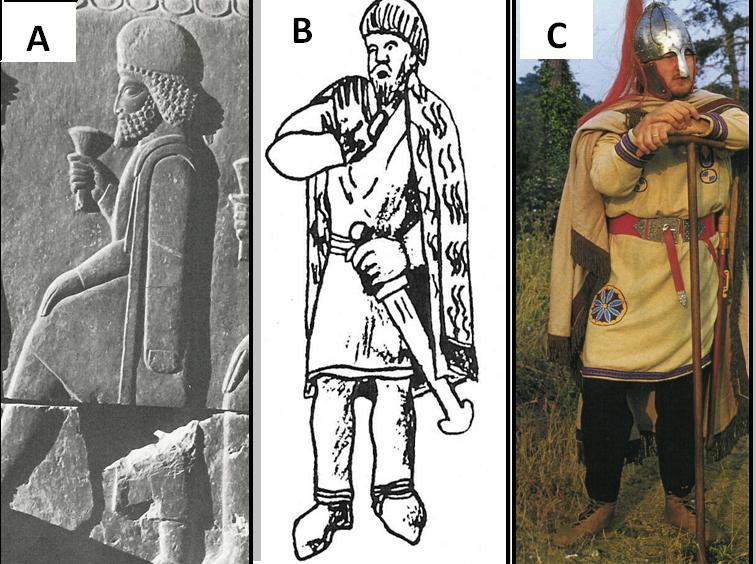 The Iranian Kandys cape and its legacy in Europe (click to enlarge). (A) Medo-Persian nobleman from Persepolis wearing the Iranian Kandys cape of the nobility 2500 years past (B) figure of Paul dressed in North Iranian/Germanic dress from a 5th century ivory plaque depicting the life of Saint-Paul (C) reconstruction by Daniel Peterson (The Roman Legions, published by Windrow & Greene in 1992, p.84) of a 4th-5th century Germanic warrior wearing Iranian style dress and the Kandys. The Iranian Persepolis styles of arts and architecture continued to exert a profound influence far beyond its borders for centuries after its destruction by Alexander (Pictures used in Kaveh Farrokh’s lectures at the University of British Columbia’s Continuing Studies Division and Stanford University’s WAIS 2006 Critical World Problems Conference Presentations on July 30-31, 2006).
The Iranian Kandys cape and its legacy in Europe (click to enlarge). (A) Medo-Persian nobleman from Persepolis wearing the Iranian Kandys cape of the nobility 2500 years past (B) figure of Paul dressed in North Iranian/Germanic dress from a 5th century ivory plaque depicting the life of Saint-Paul (C) reconstruction by Daniel Peterson (The Roman Legions, published by Windrow & Greene in 1992, p.84) of a 4th-5th century Germanic warrior wearing Iranian style dress and the Kandys. The Iranian Persepolis styles of arts and architecture continued to exert a profound influence far beyond its borders for centuries after its destruction by Alexander (Pictures used in Kaveh Farrokh’s lectures at the University of British Columbia’s Continuing Studies Division and Stanford University’s WAIS 2006 Critical World Problems Conference Presentations on July 30-31, 2006).
Both the nature and the number of the analogies I have remarked satisfy my own mind that they are more truly referable to the latter than to the former cause, and therefore I will proceed to enumerate them, as corroborating testimony of our Sacassenian derivation, beginning with the Persian affinities, and then proceeding to those of the Zend and the Pehlvi.
PERSIAN, ANGLO-SAXON
am, I am.
aelan, to burn
alaw, a flame of fire
afora, a son
afa, the eldest son
andega, an appointed term
andan, a term
abidan, to abide
abadan, an abode
are, honour
aray, decoration
arian, to honour
arayidan, to adorn
ase, as
asay, like
andget, the intellect, sense
angar, reason.
andgashtan, to think
enge, trouble
anjam, grief.
andjugh, a sigh
angel, a hook
angulah, a button
ewe, water
aw, water
earmth, misery
urman, trouble
ende, the end
anjam, the end
berend, fruitful
bar, fruit
beeran, to carry
bar, a load
brother, a brother
bradar, a brother
barn, a barn
barn, a covered place
bearn, a son
barna, a youth
bedan, to offer
bedroz, a present
balew, depraved
bulad, a malefactor
beal, destruction
bulaghan, a calamity
bilewite, simple
biladah, foolish
beado, cruelty
bada, wickedness
barbacan, a front tower
burbik, a portico
bur, a chamber
barkh, an open room
blessian, to bless
balistan, to bless
blad, fruit, the blade
balidan, balandan, to grow
basing, a pallium, a chlamys
basuian, to be clothed in purple
baz, a habit, rich dress
bered, vexed
barat, disgusted tired
beard, a beard
barbar, a barber
breost, the breast
bistan, the breast
bysmor, infamy
bazat, a crime.
basaj, depravity
bysgu, business
bishing, business
bile, the beak, the bill
bull, the beak
bio, I exist
bud, existence
benn, a wound
bunawar, a sore
bil, a mattock
blowan, to flower
bilak, a flower
bidan, to expect, to await
bidar, watching.
bidari, vigilance
byld, firmness
bilah, firm
bend, a bond
band, a band, a chain
bendan, to bind
bandan, bandidan, to bind
bold, a town
balad, a city
bolt, a house
bulud, a dwelling
byan, to inhabit.
binland, cultivated land
bingha, a dwelling
beam, the sunbeam.
beamian, to beam
bam, the morning
sifer, pure, chaste
saf, pure
safa, purity
samod, together, in like manner
saehim, a partner, even
mirran, to hinder
maraw, go not.
marang, a bar
man, wickedness
mang, cheating, a thief
mona, the moon
mang, the moon
mxden, a maiden
madah, a female
moder, mother
madar, mother
mara, the night-mare
mar, sick
mal, pay, reward, tribute
malwar, rich
maldar, a rich man
mani, many
mali, many
morth, death
murda, dead
morther, murder
murdan, to die
mearc, a limit
marz, a limit
mus, a mouse
murz, a mouse
must, new wine
mustar, new wine
na, not
nah, not
naegl, a nail
nakhun, a nail
nafel, the navel
nal; the navel
nama, a name
nam, a name
iiameutha, illustrious
nami, illustrious
necca, the neck
nojat, the collar
neow, new
no, new
nu, now
nun, now
nigan, nine
nuh, nine
hol, health
hal, quiet, firmness
hare, hoary
harid, venerable
isa, ice
hasir, ice
eam, I am
hayam, I am
iuc, a yoke
yugh, a yoke
rad, a road
rah, a road
reste, quiet
rast, secure
duru, a door
dar, a door
deni, slaughter
dam, a groan, black blood
dim, obscure
damah, a cloud
gabban, to deride
ghab, a foolish bitter expression
gaf, loquacious
guftan, speech, to relate
cu, a cow
go, a cow
gers, grass
gryah, grass
gifr, greedy
guri, avarice
faeen, fraud
faj, a lie
sum, some
suman, a little
reel, prosperity
salaf, luxurious
steorra, a star
sitarah, a star
losewest, deception
losidan, to deceive
leogan, to tell a lie
lay, lying
hlogun, they laughed
lagh, a jest. lof, praise
laf, praise
lufa, love
laheb, love
lam, lame
lam, crooked
lang, lame
lippa, the lip
law, the lip
laf, the remainder
lab, remaining
less, the less
lash, small
lar, learning
lur, ability
lust, delight
lustan, to sport
lust, luxuriousness
lashan, nice, soft
blyd, tumult.
hlydan, to rage, to make a noise
lud, furious altercation
list, knowledge
listum, skilfully
lazir, clever
thu, thou
to, thou
thinan, to decline, to become thin
tanik, thin
tinterg, torment
tang, tight
tintregan, to torture
tangi, anguish
tawian, to cultivate
tan, an inhabitant
teman, to teem, to bring forth abundantly
toma, twins
wen, hope
awanidan, to hope
wenan, to expect
awanidan, to expect
ysel, a spark
azar, fire
raene, pride, glorying
awrang, power, glory
ae, a law
aym, a law
paeca, a deceiver
pak, vile
paecan, to deceive
pakh, ingratitude
paeth, a path, a footway
pay, pa, a footstep
pal, a stake
palar, a beam of wood
paell, colour
paludan, to besmear
pyndan, to shut up, impound
pynding, a fettering
paywand, a chain, a shackle
to, to
ta, to
taer, a tear
tar, moist
tarb, torture
taeran, to tear
tarakidan, to split
telan, to tell
talagh, a voice
teiss, affliction
tasah, grief
teisse, a stripe
tazyanah, a scourge
tir, a lord. tir, a chief
tir, glory
tur, a hero, bright
siofotha, bran
sapos, bran
seel, time
sal, a year
seepah, age
sul, a plough
suli, a plough
sac, discord, quarrel
sakht, violent, stubborn
sur, surig, sour
sirka, sirkah, vinegar
salh, a willow
salah, a wicker-basket
sorg, sorrow. sog, grief
sugwar, sorrowful
sol, solen, a shoe, a sandal
salu, a coarse shoe
supwah, a shoe
sole, the sole
sul , the sole
thunar, thunder
tundar, thunder
thunrian, to thunder
tundidan, to thunder
tan, a bud
tundar, the bud of a leaf
It is remarkable that all, or nearly all, of the Anglo-Saxon words spelt in the Lexicon with sc, which are now used in our English phrase, are at present pronounced by us as sh, and are written with this orthography. Thus the Anglo-Saxon sceap, scyp, sco, scine, and sceam, are spoken by us as sheep, ship, shoe, shine, and shame.
Whether the sh was the original sound of those words, which, by a sort of conventional orthography, were written as sc by our ancestors, to distinguish their sound of sh from the proximate one of s, or whether it became changed by one of those gradual alterations of pronunciation which occur in all languages from various causes, we cannot now decide; but the Persian has some analogous terms with the sh, instead of the sc, as
sea, excellent
shadbash, excellent
seama, shame, bashfulnes
sharm, shame, bashfulness
shama, naked
sceaming, confusion
shamidan, to be confounded
sceaphan, to shape, to put in order
shaplidan, to smooth
sceaft, a shaft, an arrow
shaftu, a quiver
sceaft, a point
shafar, the edge
sceawian, to see
shuwaz, the eye.
The other resemblances which I have remarked between these two languages are:
faegan, glad
farghan, gladness
faeran, to go
feridan, to walk
faroth, a journey
faraz, progress
fyr, fire
faroz, inflaming
ferhth, the mind
farzah, wisdom, knowledge
ferht, fear, fright
farasha, dread, trembling
The congruities which I have perceived in the few specimens that have been published of the Zend with the Anglo-Saxon are the following:
beran, to bear
bereete, to bear
ba, both
betim, the second
the, thee
te, thee
eahta, eight
aschte, eight
dochter, daughter
dogde, daughter
dohte, he did
daschte, he did
steorran, stars
staranm, stars
frend, a friend
frem, a friend
feder, a father
feder, a father
mid, with
mad, with
meder, mother
mediehe, mother
medo, mead
medo, wine
me, me
man, me
metan, to measure
meete, measure
med, a recompense
mejdem, a recompense
maest, chief
meze, meso, great
micle, much
mesche, much
mecg, a man
meschio, a man
mal more
mae, great
na, not
noued, not
nafel, the navel
nafo, the navel
we, an oak
hekhte, an acorn
hera, a lord.
heretoge, a chief
herete, a chief
paeth, a path
petho, a way
purl pure
peratche, pure
uppa, above.
upper, above
opero, above
threo, three
thre, three
thrydde, the third
thretim, the third
thu, thou
thvanin, thou
bane, a floor, a board
baenthro, a floor, a board
rot, splendid.
rof, illustrious
erode, illustrious
astandan, to subsist
asteouao, existence
beoth, they are
beouad, he is
beo, be it
boiad, be it
theof, a thief
teio, a great thief
dreori, dreary
drezre, a desert
daeth, death
dajed, he is no more
rewa, order
reso, he puts in order
reswian, to reason
razann, intelligent
froe, a lord
frethem, greatness
guast, the spirit
gueie, the soul
mxnde, he mentioned
manthre, words
midda, middle
meiao, middle
morth, death
mrete, mortal
merran, to mar
merekhsch, to destroy
gear, year
yare, year
earmth, poverty
armete, humility
starian, to look at
astriete, he sees
ba, both
bee, two
singan, to say
senghan, a word
scir, sheer, pure
srere, pure
snid, a cut
snees, he strikes
seon, to see
sodern, to see
gnad, he bruised
ghnad, he strikes
athe, easy
achiato, easy
scina, shina, brilliant
scheeto, brilliant.
I will now only trouble the Society with the few coincidences that I have found in looking over Mr. Anquetil’s short vocabulary of the Pehlvi, as he has printed it from his old manuscripts.
bonda, one bound
bandeh, a slave
nam-cutha, famous
nameh, famous
starian, to look at
astared, he sees
halig, holy
halae, pure
eahta, eight
ascht, eight
sare, troublesome
sareh, wicked
morth, death
marg, mortal
a-marg, immortal
thu, thou
tou, thou
sex, six
sese, six
bysmor, opprobrium
besche, wicked
suht, languor
satoun, weak
dom, legal judgment
din, law
reasan, to attach
resch, a wound
secgan, to say
sokhan, a word
gaf, loquacious
goft, he said
ofer, over, above
avvar, above
dem, slaughter
damma, blood
med, recompense
mozd, recompense
cneou, knee
djanouh, knee
steorran, stars
setaran, stars
setnian, to be in ambush
sater, war
sceacan, shakan, to shake, to pluck
schekest, he breaks
athe, easy
asaneh, easy
cu, cow
gao, ox or cow
ma, more
meh, great
bar, bare
barhene, naked
morth, death
mourd, he dies
mourdeh, mortal
meder, mother
amider, mother
nafel, the navel
naf, the navel
na, no
na, not
bog, a branch
barg, a leaf
purl, pure
partan, pure
agytan, to understand
agah, understanding
ac, an oak
akht, an acorn
brader, brother
berour, brother
bye, a habitation
bita, a house
secg, a little sword
saex, a knife
sakina, a knife
clypian, to call out
cald, called
kala, crying out
mare, greater
mar, great
necan, to kill
naksounan, I kill
band, a joining
banda, a band
raed, a road
raeh, a way
eortha, earth
arta, earth.
From what I have seen of the three languages of ancient and modern Persia which I have inspected, I think that by a more elaborate investigation of all their analogies with the Anglo-Saxon, a greater number of satisfactory congruities might be traced.
But the preceding specimens will perhaps be sufficient to support the probability of the geographical derivation of our ancestors from the vicinity of the Caspian and of Persia; and we are now too many centuries removed from the actual period of the migration, to have any stronger evidence upon it than that of warrantable inference and reasonable probability.
I have the honour to be,
SHARON TURNER
32, Red Lion Square
22nd March, 1827.
N.B. – Since this letter was written, I have found several affinities of Anglo-Saxon words with others in the Arabic, Hebrew, Chinese, Sanskrit, Japanese, Coptic, Laplandish, Georgian, Tongo, Malay, and Susov, which are printed in the fifth edition of the Anglo-Saxon History [The History of the Anglo-Saxons].
These present a range of similitude, amid general dissimilarity, which corroborates the principle formerly stated – of the original unity of the primeval language, and of its subsequent abruption on the compulsory dispersion of mankind.
But these affinities are not, in each language, near so numerous as the preceding collections from the Persian and its cognate dialects; and therefore do not lessen the weight of the argument, that so many Persian correspondences with the Anglo-Saxon, favour the derivation of the latter nation from the ancient Sakasani, who inhabited the regions near the Kur.



